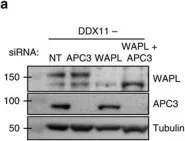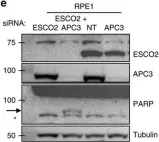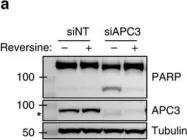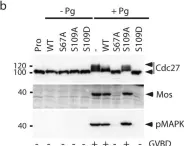MAD2L2 is a small HORMA domain protein that plays a crucial role in DNA repair and mitosis. In both TLS and shieldin, the dimerization of MAD2L2 via its HORMA domain is critical for the stability and function of these complexes. However, in mitosis, the dimerization state of MAD2L2 remains unknown. To assess the importance of MAD2L2's dimerization during mitosis, we utilized CRISPR/Cas9 to generate MAD2L2 knockout cells, which were subsequently complemented with MAD2L2 species carrying different dimer-disrupting point mutations. We assessed the ability of these MAD2L2 dimer-disrupting mutants to regulate mitosis by evaluating early mitotic events and mitotic fidelity. Our findings indicate that MAD2L2 can function in its monomeric form during mitosis, suggesting that MAD2L2 homodimerization is dispensable for early mitotic regulation. Furthermore, our results suggest that the binding of CDH1 to MAD2L2 is a key regulating factor in mitosis that may actively prevent the formation of MAD2L2 dimers, thereby shifting the cellular balance toward MAD2L2-CDH1 interaction. Thus, the equilibrium between the monomeric and dimeric forms of MAD2L2 is an important cellular factor regulating the MAD2L2-containing complexes.
Product Citations: 31
MAD2L2 Dimerization Is Not Essential for Mitotic Regulation.
In International Journal of Molecular Sciences on 25 October 2024 by Barda, N., Ayiku, P. J., et al.
-
WB
-
Homo sapiens (Human)
-
Cell Biology
Bipartite binding interface recruiting HP1 to chromosomal passenger complex at inner centromeres.
In The Journal of Cell Biology on 2 September 2024 by Sako, K., Furukawa, A., et al.
Maintenance of ploidy depends on the mitotic kinase Aurora B, the catalytic subunit of the chromosomal passenger complex (CPC) whose proficient activity is supported by HP1 enriched at inner centromeres. HP1 is known to associate with INCENP of the CPC in a manner that depends on the PVI motif conserved across HP1 interactors. Here, we found that the interaction of INCENP with HP1 requires not only the PVI motif but also its C-terminally juxtaposed domain. Remarkably, these domains conditionally fold the β-strand (PVI motif) and the α-helix from a disordered sequence upon HP1 binding and render INCENP with high affinity to HP1. This bipartite binding domain termed SSH domain (Structure composed of Strand and Helix) is necessary and sufficient to attain a predominant interaction of HP1 with INCENP. These results identify a unique HP1-binding module in INCENP that ensures enrichment of HP1 at inner centromeres, Aurora B activity, and thereby mitotic fidelity.
© 2024 Sako et al.
-
Cell Biology
-
Genetics
Dual TTK/PLK1 inhibition has potent anticancer activity in TNBC as monotherapy and in combination.
In Frontiers in Oncology on 26 August 2024 by Zanini, E., Forster-Gross, N., et al.
Threonine tyrosine kinase (TTK) and polo-like kinase 1 (PLK1) are common essential kinases that collaborate in activating the spindle assembly checkpoint (SAC) at the kinetochore, ensuring appropriate chromosome alignment and segregation prior to mitotic exit. Targeting of either TTK or PLK1 has been clinically evaluated in cancer patients; however, dual inhibitors have not yet been pursued. Here we present the in vitro and in vivo characterization of a first in class, dual TTK/PLK1 inhibitor (BAL0891).
Mechanism of action studies utilized biochemical kinase and proteomics-based target-engagement assays. Cellular end-point assays included immunoblot- and flow cytometry-based cell cycle analyses and SAC integrity evaluation using immunoprecipitation and immunofluorescence approaches. Anticancer activity was assessed in vitro using cell growth assays and efficacy was evaluated, alone and in combination with paclitaxel and carboplatin, using mouse models of triple negative breast cancer (TNBC).
BAL0891 elicits a prolonged effect on TTK, with a transient activity on PLK1. This unique profile potentiates SAC disruption, forcing tumor cells to aberrantly exit mitosis with faster kinetics than observed with a TTK-specific inhibitor. Broad anti-proliferative activity was demonstrated across solid tumor cell lines in vitro. Moreover, intermittent intravenous single-agent BAL0891 treatment of the MDA-MB-231 mouse model of TNBC induced profound tumor regressions associated with prolonged TTK and transient PLK1 in-tumor target occupancy. Furthermore, differential tumor responses across a panel of thirteen TNBC patient-derived xenograft models indicated profound anticancer activity in a subset (~40%). Using a flexible dosing approach, pathologically confirmed cures were observed in combination with paclitaxel, whereas synergy with carboplatin was schedule dependent.
Dual TTK/PLK1 inhibition represents a novel approach for the treatment of human cancer, including TNBC patients, with a potential for potent anticancer activity and a favorable therapeutic index. Moreover, combination approaches may provide an avenue to expand responsive patient populations.
Copyright © 2024 Zanini, Forster-Gross, Bachmann, Brüngger, McSheehy, Litherland, Burger, Groner, Roceri, Bury, Stieger, Willemsen-Seegers, de Man, Vu-Pham, van Riel, Zaman, Buijsman, Kellenberger and Lane.
The deubiquitylase USP31 controls the Chromosomal Passenger Complex and spindle dynamics
Preprint on BioRxiv : the Preprint Server for Biology on 17 August 2022 by Bertsoulaki, E., Glover, H. L., et al.
We have identified USP31 as a microtubule and centrosome associated deubiquitylase, depletion of which leads to an increase in individual cell mass and defective proliferation. We have examined its dynamics and impact during mitosis. GFP-USP31 associates with the mitotic and central spindles, its levels are increased 2-3-fold in prometaphase compared to asynchronous cells and it is dynamically phosphorylated in a CDK1 dependent manner. We find that USP31 depleted cells display altered spindle morphology and chromosomal segregation errors, whilst stable expression of a catalytically inactive form of USP31 leads to polyploidy. At prometaphase, levels of multiple CPC components are destabilised, most prominently INCENP. Under anaphase conditions, depletion of USP31 impairs the translocation of both endogenous and ectopically expressed INCENP to the spindle mid-zone, whilst expression of catalytically inactive USP31 results in multiple ectopic cleavage furrows. In summary, our data indicate a multifaceted regulatory role for USP31 during mitosis, with a profound impact on chromosomal passenger complex abundance, dynamics and function.
-
Genetics
MDA-MB-157 Cell Line Presents High Levels of MAD2L2 and Dysregulated Mitosis.
In Anticancer Research on 1 October 2020 by Pernicone, N., Peretz, L., et al.
Accurate regulation of the spindle assembly checkpoint (SAC) and anaphase promoting complex/cyclosome (APC/C) are essential for the correct execution of mitosis. In this work, we focused on MAD2L2 (REV7), a central translesion (TLS) protein, which also functions as a mitotic regulator by inhibiting APC/C in prometaphase.
Using bioinformatics analysis, live cell imaging and APC/C protein binding and degradation assays, we explored the influence of MAD2L2 over-expression in breast cancer.
A significant over-expression of MAD2L2 was found in triple negative breast cancers (TNBC), compared to other breast cancers, correlating to poor patient prognosis. We also identified significant over-expression of MAD2L2 in the MDA-MB-157 triple negative (TN) cell line. A high percentage of MDA-MB-157 cells failed to complete mitosis and died during mitosis or shortly after. In addition, these cells completed mitosis at a significantly slower rate than control cells. MDA-MB-157 cells present high levels of mitotic slippage upon nocodazole treatment and acute dysregulation in APC/C function and substrate degradation. Moreover, silencing of MAD2L2 in the MDA-MB-157 cell line improved mitotic phenotypes.
MAD2L2 over-expression supports the carcinogenic phenotype of MDA-MB-157 cells by promoting uncontrolled mitosis.
Copyright© 2020, International Institute of Anticancer Research (Dr. George J. Delinasios), All rights reserved.
-
Homo sapiens (Human)
-
Cancer Research
-
Cell Biology
In Int J Mol Sci on 25 October 2024 by Barda, N., Ayiku, P. J., et al.
Fig.3.C

-
WB
-
Homo sapiens (Human)
Collected and cropped from Int J Mol Sci by CiteAb, provided under a CC-BY license
Image 1 of 6
In Nat Commun on 1 October 2015 by de Lange, J., Faramarz, A., et al.
Fig.2.C

-
WB
-
Homo sapiens (Human)
Collected and cropped from Nat Commun by CiteAb, provided under a CC-BY license
Image 1 of 6
In Nat Commun on 1 October 2015 by de Lange, J., Faramarz, A., et al.
Fig.4.A

-
WB
-
Collected and cropped from Nat Commun by CiteAb, provided under a CC-BY license
Image 1 of 6
In Nat Commun on 1 October 2015 by de Lange, J., Faramarz, A., et al.
Fig.4.E

-
WB
-
Collected and cropped from Nat Commun by CiteAb, provided under a CC-BY license
Image 1 of 6
In Nat Commun on 1 October 2015 by de Lange, J., Faramarz, A., et al.
Fig.5.A

-
WB
-
Collected and cropped from Nat Commun by CiteAb, provided under a CC-BY license
Image 1 of 6
In Nat Commun on 15 February 2014 by Dupré, A., Daldello, E. M., et al.
Fig.3.B

-
WB
-
Collected and cropped from Nat Commun by CiteAb, provided under a CC-BY license
Image 1 of 6





